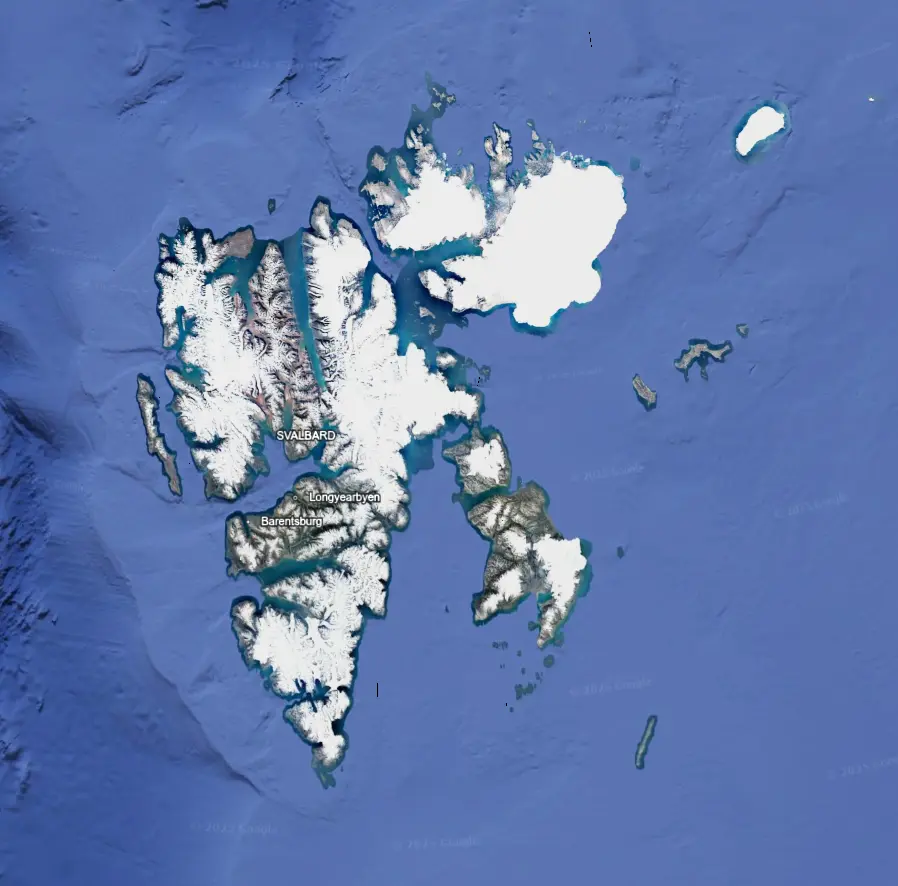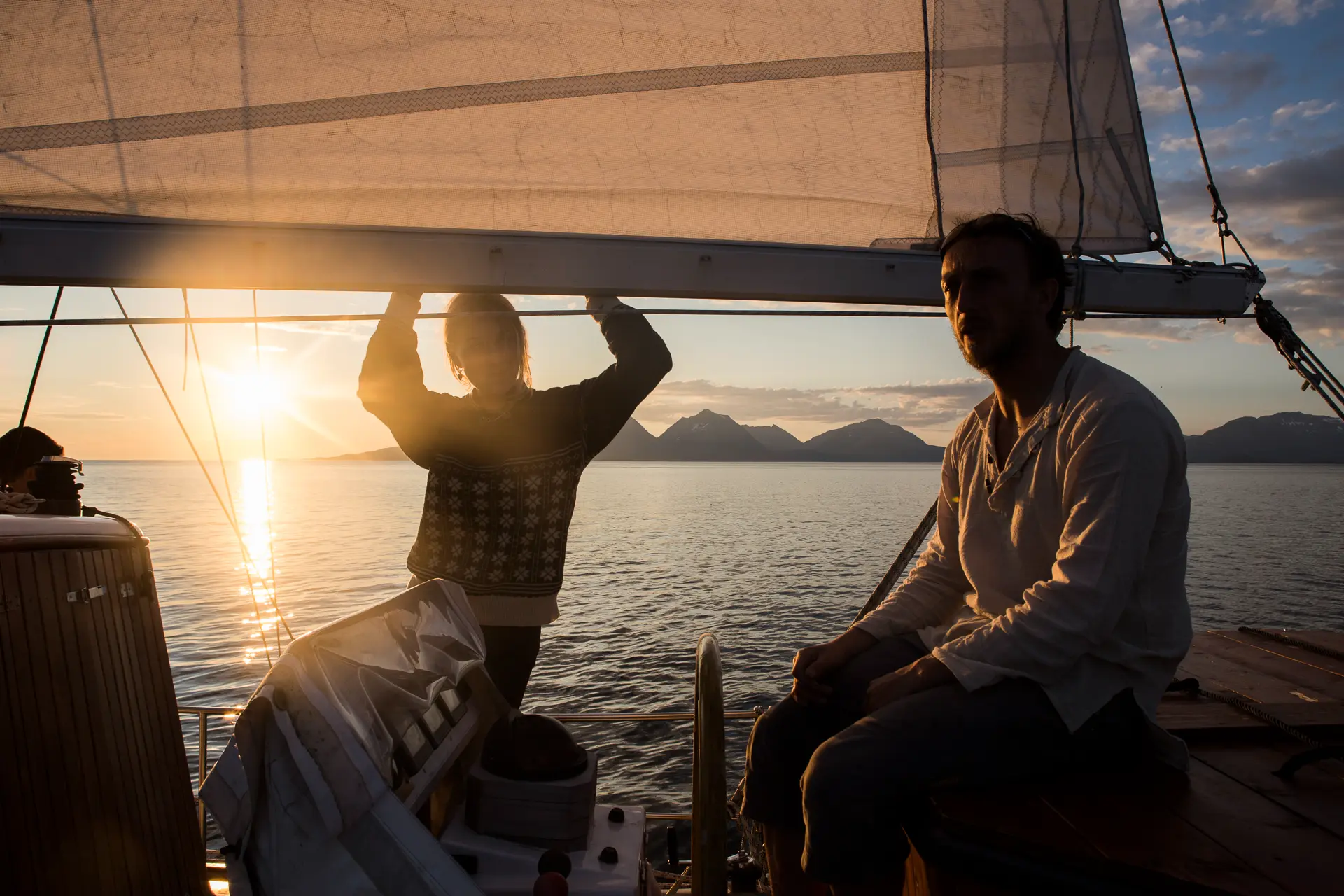Ski & Sail Svalbard - May 16
Just over a thousand kilometres from the North Pole lies Spitsbergen, surrounded by the deep silence of the Arctic Ocean. When the sea ice along the west coast begins to retreat in spring and the fjords open to the sea, a special season begins: from mid-April to early June, the light returns, the snow settles, and the conditions for ski touring are at their finest.
From Longyearbyen, we set course along the wild west coast on our Ski & Sail Expedition. Our goal is simple: to seek solitude, summits, and the untamed beauty of the high Arctic. Together with our tour partner Alpine Welten, our experience here spans years of exploration, from guiding scientific teams and ski expeditions to traversing Svalbard by tent and sled. We share a deep respect for this fragile landscape and its rhythm.
The ski descents lead straight to the sea – past sharp ridges, blue glaciers and quiet, ice-filled bays. It’s no wonder so many guests describe this journey as one of their most profound mountain experiences.
Our expedition yacht Ylva serves as a comfortable, floating basecamp throughout the voyage. Between ski days she carries us safely to new fjords and anchorages. With luck, we may encounter humpback or sperm whales along the way. On Prins Karls Forland we often visit a walrus colony, and perhaps – from a respectful distance – even glimpse the Arctic’s true monarch: the polar bear. These rare moments are the quiet jewels of this adventure of a lifetime.
Arctic isolation
Svalbard is a Norwegian island halfway between the mainland and the North Pole.
The capital, Longyearbyen, is as far north as you can get travelling on a regular scheduled flight.

Each day a new adventure
As Ylva sails between anchoridges and harbors, new peaks and new possibilities emerge.
The flight from Oslo to Longyearbyen takes only a few hours – yet it feels like entering another world. The contrast to mainland Norway is immense: here, nature dominates, vast and unbroken, clear and impossibly beautiful.
In Longyearbyen, our mountain guide will meet you upon arrival. He has already prepared the vessel and logistics for the days ahead. From the small airport, we head directly to the nearby harbour where Ylva awaits.
That same evening we set sail, leaving the last traces of civilisation behind as we glide through the ice-free Isfjorden toward Oscar II Land. Behind us, the lights of Longyearbyen fade. Ahead lies the wide stillness of the Arctic.
By late evening, we reach the sheltered Trygghamna fjord and drop anchor. Surrounded by steep mountains and year-round open water, this quiet anchorage gives a first taste of the terrain to come.
Onboard, our first shared dinner awaits. Outside, Ylva rests calmly in the cold, clear water, embraced by rock, snow, and silence. Overhead, the midnight sun lingers above the horizon, painting the landscape in deep golds and reds. Day and night merge into one long Arctic glow. It’s the beginning of a remarkable week – of ski touring, vast horizons, and an intimate connection with the far north.
After our first night aboard, the day begins with a shared breakfast in the soft glow of Arctic light. Outside, the midnight sun glides gently across snow-covered peaks — the perfect moment to prepare for our first adventure.
By late morning, we set foot on land for the first time in this wild, untouched landscape. Using our sturdy Zodiac, we reach a suitable landing site — chosen flexibly according to weather, snow, and ice conditions. Among our possible routes are striking summits like Protektorfjellet (849 m), the distinctive Alkhornet (616 m), or Värmlandsryggen (575 m) further east.
From the top, an immense panorama unfolds: glaciers, fjords, open sea — and silence, broken only by the whisper of skis on snow. The vastness and stillness of the Arctic reveal their full power.
Under the midnight sun, there is no rush — the day never ends. Those who wish can take a second tour in the golden evening light, when the low sun transforms the landscape into a scene of deep glow and calm. Others may linger aboard the yacht: a cup of tea in hand, watching drifting ice pass quietly by. The day fades softly, filled with stillness and satisfaction.
In the days ahead, our route is guided by the arctic sea ice — and with it, the choice of our daily ski objectives. When conditions allow, we follow the Forlandsundet north, between Oscar II Land and Prins Karls Forland, all the way to Ny-Ålesund — one of the northernmost inhabited settlements on Earth. The further we venture into this remote region, the greater our chances of spotting the Arctic’s monarch: the polar bear. For safety, our mountain guides are always armed and trained for all eventualities.
The landscape around us is one of overwhelming beauty — steep mountains, glittering glaciers, sculpted icebergs drifting across open water. A world both raw and graceful, silent and immense. Between ski tours, we return to the warmth and comfort of our sailing yacht — our floating refuge in the frozen wilderness. Meals prepared in the galley become something more than food: shared moments of warmth and quiet celebration.
Each day brings new encounters. We are likely to see seals or walruses resting on the ice. Sometimes a whale glides silently past the boat — or, with luck, a polar bear crosses the ice in the distance. These moments — unplanned, unfiltered, unforgettable — stay with you long after the voyage ends.
Late on the seventh evening, we sail back to Longyearbyen. But the journey isn’t over yet. The small Arctic capital has its own charm — perhaps time remains for a drink in one of its cozy bars, sharing stories of the days behind us.
Our final night is spent aboard, with the midnight sun still hovering above calm water — and the quiet satisfaction of knowing we have been part of something truly rare.
Life on board Ylva

A selection of cabin options
Our two rear cabins (nos. 3 and 4) both have double beds and generous storage space. Waking in the morning to the view of the sea is unforgettable.

Comfort for everyone
All cabins have private bathrooms and heads (one share with the guide cabin). Warm duvets, blankets, towels and toiletry is provided.

Nature provides
We are proud of our Norwegian food culture, and the abundance that nature provides in the sea.
Our guests will at the very least enjoy the bounty with us through our menu composed with love. If we are lucky, we may even catch our own dinner, and you can learn how to cook the Norwegian way.

Be a part of the crew
On board our experienced captain and mate will ensure safety and comfort for all, while allowing our guest the opportunity to take part and learn our love for sailing and and our arctic waters.
Requirements
To enjoy this trip, your skiing and mountaneering skills needs to be at or above a certain level. We use the reference system from our tour partner Alpine Welten.
Difficulty
WS – moderately difficult, up to 35°
Fitness
Good physical condition for ski tours with a total duration of around 6 hours.
Elevation
Up to 1,400 vertical metres in ascent and descent
Tour character
Serious alpine terrain / objective hazards present
Skills required
Confident use of ski touring equipment, including kick turns and ski crampons
Safe and controlled skiing in all snow conditions
Team spirit and willingness to assist on board
Important note
This voyage takes place in an environment with inherent risks due to remoteness and Arctic conditions. Participants must be aware of and prepared for the demands of expedition travel.
Nice to know
Here are some common questions from our guests.
We provide a full board to all our guests on Ylva, and it is our goal that your experience with us is one of warmth and comfort.
We serve 3 delicious meals each day; Breakfast, lunch and dinner. Usually, lunch is taken on the slopes, and we provide options to pack and bring your own from the boat in cooperation with the guide. There is always snacks and fruits available should you feel the need for more energy. Coffee, tea, juice and milk is complementary. Beer and wine is for sale on board.
Your bunk is equipped with comfortable linen and a warm down duvet. There are towels and soaps for your use in your bathroom.
Sailing in the Arctic can be cold and windy in winter. However, Ylva is a large boat, and only rarely will there be much sea spray over deck. Your skiing gear - goretex trousers and jackets, with proper woolen layers as well as mid-layers underneath, will usually be sufficient.
However, Ylva has an indoor steering house, so going on deck to work the sails is only done during manouvers and sail changes, and assisting the crew in these phases is a voluntary experience.
Longyearbyen Airport (LYR) is reachable only from the Norwegian mainland. The carriers that serve the route are Scandinavian Airlines and Norwegian. You may find flights from Tromsø (TOS), but the easiest is to fly directly from Oslo (OSL).
Norway abides by the Svalbard Treaty that grants rights to citizens of signatore states equal rights on the island. Therefore, Svalbard is not part of Schengen even though the rest of Norway is. Make sure you bring your passport. If you do not, you may be refused boarding.
You will receive more detailed information after you book your tour.
Yes, each cabin has a private shower and toilet, except one of the forward cabins (nr. 2) that shares these with the guides. Towels and toiletries are provided.
We provide protected storage for all skis in large crates on deck. Ski boots are kept in a locker behind the steering house, to save space inside. All your equipment is safe from sea spray and other sources of dirt.
Indeed there is!
We fill it up with sea water and heat it with a wood-burning stove. Our goal is to fire it up at least a couple of times each trip. The stove can comfortably hold six people, but a couple more can fit between good friends.
On a boat, we strongly recommend that you pack in soft bags that can be rolled up and stowed away. A suitcase would pose a problem to store in your cabin.
As you are a skiier, you are probably well aware of how to dress in winter conditions. Just make sure you keep in mind that the wind in Norway can be strong, adding to the other challenges of low temperatures and humidity.








